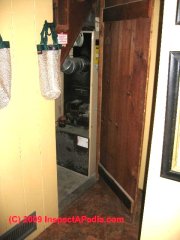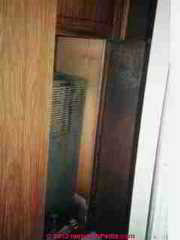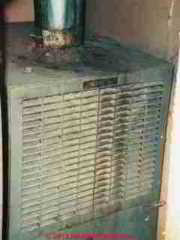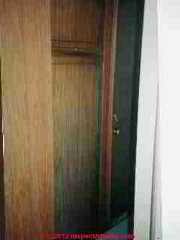 Combustion Air Requirements for Mobile Homes
Combustion Air Requirements for Mobile Homes
Combustion Air Problems in Trailers, Doublewides, Mobile Homes
- POST a QUESTION or COMMENT about combustion air requirements and safety hazards for oil and gas fired heating appliances
Combustion air defects & hazards in mobile homes:
This article illustrates a mobile home heating system that was unsafe because of inadequate combustion air. The unsafe conditions were easilyi detectable by visual inspection without requiring special tests or instruments.
This article series explains how to recognize and fix combustion air defects on heating appliances such as boilers, furnaces, and water heaters. These articles answer most questions about central hot water heating system troubleshooting, inspection, diagnosis, and repairs.
Our photo at page top shows a mobile home oil fired furnace installed in a closet with an airtight door; there was no outside combustion air supply. The heating system could not work properly nor safely in this home.
InspectAPedia tolerates no conflicts of interest. We have no relationship with advertisers, products, or services discussed at this website.
- Daniel Friedman, Publisher/Editor/Author - See WHO ARE WE?
Combustion Air Defects & Safety Hazards at Mobile Home Heating System
Watch out: inadequate combustion air supply to a gas burner (and less often to an oil burner) is very dangerous and can produce potentially fatal carbon monoxide. If you suspect unsafe heating system operation or a carbon monoxide problem be sure everyone leaves the building immediately and then call your local fire department for assistance.
Here our two photographs illustrate several unsafe conditions at a house trailer's heating system. There are no return air flow from the conditioned (occupied) space to the furnace warm air intake, questions about adequate combustion air, and dirt blocked air flow passages.

- No return air from occupied space to the furnace: Above we notice that when the door to the "furnace closet" in this mobile home is shut, there is no return air movement from the home's heated interior to the furnace - creating the most-expensive possible way to operate the furnace. We call this a "one way" heating system: scrounge some air from a cold outdoor or crawl space source, heat it, and blow it into the living space.

In addition to the absence of return air to the heating furnace we notice that
- Dirt blockage of air flow: the return air inlet grille is partly blocked by dust and debris, further reducing air flow, increasing heating cost, and ...
- Watch out: there is an increased risk of potentially fatal carbon monoxide poisoning if the system lacks adequate combustion air.
See CARBON MONOXIDE WARNINGS: HOME HEATERS - Blocked air filter: if an air filter is installed (remains to be discovered), given how dirty is the exterior of this furnace the air filter may be equally dirty and airflow blocked
- The leak stains and corrosion on and below the heating flue indicate that the chimney and flue are leaking, risking hidden damage, leaks, holes, water or rust damage to the furnace heat exchanger: all further pointers to an unsafe heating system
- On some of these installations combustion air is provided from outdoors through wall or floor openings in the furnace closet, increasing safety but ignoring operating cost
- Unsafe chimney outside: incomplete, leaks, missing cap, too short, bad draft - are illustrated by our outdoor heating flue/chimney photos earlier on this page.
Question: is it safe to use an un-vented heater in a mobile home?
2017/06/05 John said:
Can I install a 36000 non vented heater in a Mobil home
Reply: not without safety concerns and IAQ questions
John, for space and clarity we moved your question and our detailed reply to a new article
at UN-VENTED GAS HEATER SAFETY
...
Reader Comments, Questions & Answers About The Article Above
Below you will find questions and answers previously posted on this page at its page bottom reader comment box.
Reader Q&A - also see RECOMMENDED ARTICLES & FAQs
Question: soot problems after oil burner puffback
(Jan 6, 2015) mahgy said:
we had a furnace blow back a while ago, still noticing soot/black build up coming out of the heating vents on the walls.. this is a rental property. is this dangerous to our health? landlord does not seem concerned
Reply:
Mahgy
No one can assess exposure levels of soot nor health risks accurately from a simple e-text, but in general, breathing soot is not healthy. If the heating system is no longer producing soot (which is itself unsafe) then the duct system may need cleaning.
Question: visible clues of adequate combustion air
(June 25, 2015) Anonymous said:
What if there is no visible combustion AIR
Reply:
Anon you'd need to be more specific. Most building codes and standards discussing combustion air supply include a square-foot area size specification. For example if a heater of input BTUh amount X is in an open space of Z square feet then the area is deemed capable of providing adequate combustion air. Those guidelines presume a standard minimum rate of building air leakage or air exchange rate.
In the article above you can read details at the paragraph titled
Cubic Feet of Room Space as a Measure of Adequacy of Combustion Air: Total Input BTUH / 1000 x 50
Question: article correction
(Jan 14, 2016) Joe said:
With your cubic ft volume for adequate combustion air equation, you use 140 MBH for the total input BTU of a 180 MBH boiler and 40 MBH DHW. Should you be using 220 MBH total for that?
Reply:
hanks Joe, we've corrected the math in the article above. I appreciate your careful reading. We can use all the editing help we can get.
Question: combustion air source for water heater in a trailer
(Mar 19, 2016) Anonymous said:
does combustion air for mobile home water heaters enter from under the trailer
Reply:
Anon:
In some installations it might;
Watch Out: if your water heater is gas or oil fired and lacks adequate combustion air the unit is unsafe and could kill the home's occupants.
Question:
21 June 2016 keith preddie said:
can anyone go through the control sequence between louvered openings and the gas fired equipment?
Reply:
Keith please see our detailed answer at
inspectapedia.com/heat/Automatic_Combustion_Air_Inlet.php
COMBUSTION AIR INLET AUTOMATIC LOUVERS
...
Continue reading at UN-VENTED GAS HEATER SAFETY or select a topic from the closely-related articles below, or see the complete ARTICLE INDEX.
Orsee this
Article Series Contents
- BACKDRAFTING HEATING EQUIPMENT
- CARBON MONOXIDE - CO
- COMBUSTION AIR REQUIREMENTS
- COMBUSTION AIR SAFETY in MOBILE HOMES
- MOBILE HOME HEATING SYSTEMS
- MOBILE HOME OIL TANKS
- MOBILE HOME WATER HEATERS
Suggested citation for this web page
COMBUSTION AIR SAFETY in MOBILE HOMES at InspectApedia.com - online encyclopedia of building & environmental inspection, testing, diagnosis, repair, & problem prevention advice.
Or see this
INDEX to RELATED ARTICLES: ARTICLE INDEX to HEATING SYSTEMS
Or use the SEARCH BOX found below to Ask a Question or Search InspectApedia
Ask a Question or Search InspectApedia
Try the search box just below, or if you prefer, post a question or comment in the Comments box below and we will respond promptly.
Search the InspectApedia website
Note: appearance of your Comment below may be delayed: if your comment contains an image, photograph, web link, or text that looks to the software as if it might be a web link, your posting will appear after it has been approved by a moderator. Apologies for the delay.
Only one image can be added per comment but you can post as many comments, and therefore images, as you like.
You will not receive a notification when a response to your question has been posted.
Please bookmark this page to make it easy for you to check back for our response.
IF above you see "Comment Form is loading comments..." then COMMENT BOX - countable.ca / bawkbox.com IS NOT WORKING.
In any case you are welcome to send an email directly to us at InspectApedia.com at editor@inspectApedia.com
We'll reply to you directly. Please help us help you by noting, in your email, the URL of the InspectApedia page where you wanted to comment.
Citations & References
In addition to any citations in the article above, a full list is available on request.
- American Society of Heating, Refrigerating and Air-Conditioning Engineers (ASHRAE) Handbook - Fundamentals, 1993, Chapter 15, page 15.9 Air For Combustion.
- ASME CSD-1- Controls and Safety Devices for Automatically Fired Boilers, 1992 with addendum 1a 1993. section CG-260 Combustion Air.
- BOCA - National Mechanical Code, 1990, article 10, Combustion Air.
- NFPA 31 - Installation of Oil Burning Equipment, 1992, section 1-5 Air for Combustion and Ventilation.
- NFPA 54: National Fuel Gas Code (2015), addresses heating appliance combstion air ventilation specifications. NFPA 54, ANSI Z223.1 provides minimum safety requirements for the design and installation of fuel gas piping systems in homes and other buildings.
- NFPA 85: Boiler and Combustion Systems Hazards Code: NFPA 85 contributes to operating safety and prevents explosions and implosions in boilers with greater than 12.5 MMBTUH, pulverized fuel systems, and heat recovery steam generators.
- NFPA 87: Recommended Practice for Fluid Heaters, This recommended practice provides safety guidance for fluid heaters and related equipment to minimize fire and explosion hazards that can endanger the fluid heater, the building, or personnel
- SBCCI- Standard Mechanical Code, 1991, section 305 Combustion and Ventilation Air.
- Axtman, William H., "Combustion Air Requirements: The Forgotten Element in Boiler Rooms", Grayh Gull Associates, retired executive director of the American Boiler Manufacturers Association, National Board Technical Series, Winter 1995 National Board Bulletin. Retrieved 26 January 2015, original source: http://www.nationalboard.org/index.aspx?pageID=164&ID=191
Excerpt:
Several safety codes such as the National Fire Protection Association's standards, NFPA 54 - National Fuel Gas code, NFPA 31 - Installation of Oil Burning Equipment, and the American Society of Mechanical Engineers (ASME) CSD-l Controls and Safety Devices for Automatically Fired Boilers have sections covering the requirements for combustion air intakes. In addition, building codes such as the Building Officials and Code Administrators International (BOCA) National Mechanical Code and the Standard Mechanical Code published by the Southern Building Code Congress International (SBCCI) have air requirements for combustion.
Editor's note: Some ASME Boiler and Pressure Vessel Code requirements may have changed because of advances in material technology and/or actual experience. The reader is cautioned to refer to the latest edition and addenda of the ASME Boiler and Pressure Vessel Code for current requirements. - Nussbaumer, Thomas. "Combustion and co-combustion of biomass: fundamentals, technologies, and primary measures for emission reduction." Energy & fuels 17, no. 6 (2003): 1510-1521.
- Utiskul, Yunyong P., Wu, Neil P., Biteau, Hubert, "Combstion Air Requirements for Power Burner Appliances, Final Report", The Fire Protection Research Foundation, The Fire Protection Research Foundation
One Batterymarch Park
Quincy, MA, USA 02169-7471
Email: foundation@nfpa.org
http://www.nfpa.org/foundation, retrieved 25 Jan 2015, original source: http://www.nfpa.org/~/media/files/research/research%20foundation/rfcombustionairrequirements.ashx, Executive Summary:
Gas-fired appliances require combustion air to properly function. Adequate air is necessary for
supporting combustion of the appliance burner, dilution of flue gas, and proper ventilation of the
space where the appliance is installed. Current standards and model codes outline requirements
and methods to supply the combustion air. One method is to provide outdoor combustion air
through openings or air ducts communicating with the outdoors through natural ventilation.
Most standards require the outdoor opening(s) be prescriptively sized based on the total energy
input rating of the appliance. However, in the United States, the current standards contain no
separate provisions to address the opening size supplying the combustion air for
commercial/industrial sized appliances, which typically have a high energy input rating of
greater than 300 kBtu/hr and are equipped with a power burner unit. As a result, the opening(s)
can be excessively sized when determined based on the current standards.
This research project establishes minimum outdoor combustion air requirements specific to gasfired
appliances utilizing power burners with input ratings no greater than 12.5 MBtu/hr. A
review of the available literature, engineering guidelines, and current standards and model codes
related to combustion air requirements was performed. This report provides an understanding
of the technical basis for the existing provisions for combustion air and their applicability to
power burner appliances. This report also identifies the range of energy input ratings for gasfired
appliances equipped with power burners, and compares the combustion air requirements
specified by a range of appliance manufacturers. A theoretical model for air flow through
openings was developed and the modeling results, together with the data gathered through the
literature review, were used to provide a baseline to establish the theorized combustion air
requirements suitable for power burner appliances.
... - [1] Jeff Wilcox, "Evaluating Duct Work, How to Evaluate Furnace Duct Work & Cure Short Cycling or Inadequate Ductwork Problems" Vermont Department for Children and Families, Office of Economic Opportunity, - dcf.vermont.gov/sites/dcf/files/pdf/oeo/WAPManual/AppendixI.pdf retrieved 12/5/2013. Geoff Wilcox Vermont Office of Economic Opportunity Weatherization Assistance Program Waterbury, VT (802) 769-8376 Geoff.wilcox@state.vt.us Reference Material for the original article came from: 1. Saturn Mechanical Systems Field Guide 2. Bacharach (Rudy Leatherman)
- Field Controls provides instructions for the installation of LP and Natural Gas spill sensor switches, for example for their Gas Spillage Sensing Kit Model GSK-3, GSK-4, GSK-250M switches. Contact your heating service technician directly, or contact Field controls at fieldcontrols.com for more information. These switch models include a manual reset switch. Field Controls, Kingston NC 28504 - Tel 252-522-3031.
- Tjernlund Products provides instructions for the installation and use of their controls, including the WHKE Millivolt Interlock Kit for use with their UC1 Universal Control, MAC1E or MAC4E auxiliary controls for gas fired equipment. This document also describes Tjernlund's recommended combustion air safety check which we recommended in this article. Contact Tjernlund Products at tjernlund.com or at 800-255-4208.
- Bachrach Corporation, www.bachrach-training.com provides education for HVAC technicians. We found their web pages hanging during loading -01/2009. Readers may want to contact the company directly at: bacharach-inc.com or at 800-736-4666.
- Our recommended books about building & mechanical systems design, inspection, problem diagnosis, and repair, and about indoor environment and IAQ testing, diagnosis, and cleanup are at the InspectAPedia Bookstore. Also see our Book Reviews - InspectAPedia.
- Domestic and Commercial Oil Burners, Charles H. Burkhardt, McGraw Hill Book Company, New York 3rd Ed 1969.
- National Fuel Gas Code (Z223.1) $16.00 and National Fuel Gas Code Handbook (Z223.2) $47.00 American Gas Association (A.G.A.), 1515 Wilson Boulevard, Arlington, VA 22209 also available from National Fire Protection Association, Batterymarch Park, Quincy, MA 02269. Fundamentals of Gas Appliance Venting and Ventilation, 1985, American Gas Association Laboratories, Engineering Services Department. American Gas Association, 1515 Wilson Boulevard, Arlington, VA 22209. Catalog #XHO585. Reprinted 1989.
- The Steam Book, 1984, Training and Education Department, Fluid Handling Division, ITT [probably out of print, possibly available from several home inspection supply companies] Fuel Oil and Oil Heat Magazine, October 1990, offers an update,
- Principles of Steam Heating, $13.25 includes postage. Fuel oil & Oil Heat Magazine, 389 Passaic Ave., Fairfield, NJ 07004.
- The Lost Art of Steam Heating, Dan Holohan, 516-579-3046 FAX
- Principles of Steam Heating, Dan Holohan, technical editor of Fuel Oil and Oil Heat magazine, 389 Passaic Ave., Fairfield, NJ 07004 ($12.+1.25 postage/handling).
- "Residential Steam Heating Systems", Instructional Technologies Institute, Inc., 145 "D" Grassy Plain St., Bethel, CT 06801 800/227-1663 [home inspection training material] 1987
- "Residential Hydronic (circulating hot water) Heating Systems", Instructional Technologies Institute, Inc., 145 "D" Grassy Plain St., Bethel, CT 06801 800/227-1663 [home inspection training material] 1987
- "Warm Air Heating Systems". Instructional Technologies Institute, Inc., 145 "D" Grassy Plain St., Bethel, CT 06801 800/227-1663 [home inspection training material] 1987
- Heating, Ventilating, and Air Conditioning Volume I, Heating Fundamentals,
- Boilers, Boiler Conversions, James E. Brumbaugh, ISBN 0-672-23389-4 (v. 1) Volume II, Oil, Gas, and Coal Burners, Controls, Ducts, Piping, Valves, James E. Brumbaugh, ISBN 0-672-23390-7 (v. 2) Volume III, Radiant Heating, Water Heaters, Ventilation, Air Conditioning, Heat Pumps, Air Cleaners, James E. Brumbaugh, ISBN 0-672-23383-5 (v. 3) or ISBN 0-672-23380-0 (set) Special Sales Director, Macmillan Publishing Co., 866 Third Ave., New York, NY 10022. Macmillan Publishing Co., NY
- Installation Guide for Residential Hydronic Heating Systems
- Installation Guide #200, The Hydronics Institute, 35 Russo Place, Berkeley Heights, NJ 07922
- The ABC's of Retention Head Oil Burners, National Association of Oil Heat Service Managers, TM 115, National Old Timers' Association of the Energy Industry, PO Box 168, Mineola, NY 11501. (Excellent tips on spotting problems on oil-fired heating equipment. Booklet.)
- In addition to citations & references found in this article, see the research citations given at the end of the related articles found at our suggested
CONTINUE READING or RECOMMENDED ARTICLES.
- Carson, Dunlop & Associates Ltd., 120 Carlton Street Suite 407, Toronto ON M5A 4K2. Tel: (416) 964-9415 1-800-268-7070 Email: info@carsondunlop.com. Alan Carson is a past president of ASHI, the American Society of Home Inspectors.
Thanks to Alan Carson and Bob Dunlop, for permission for InspectAPedia to use text excerpts from The HOME REFERENCE BOOK - the Encyclopedia of Homes and to use illustrations from The ILLUSTRATED HOME .
Carson Dunlop Associates provides extensive home inspection education and report writing material. In gratitude we provide links to tsome Carson Dunlop Associates products and services.


